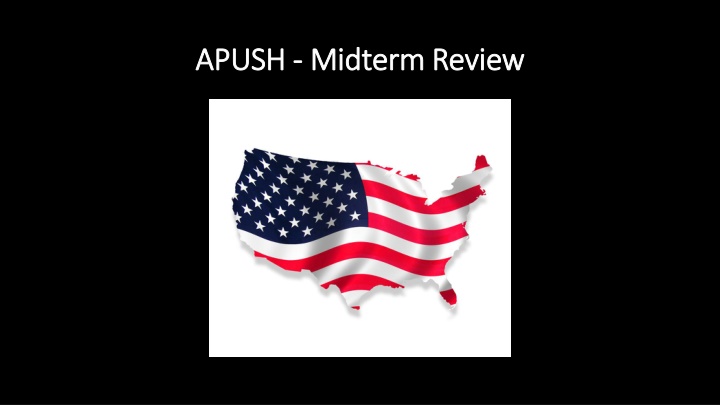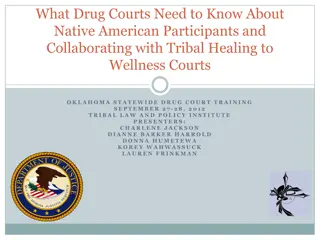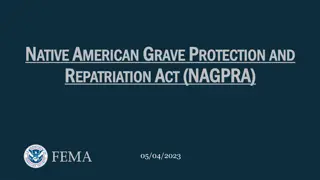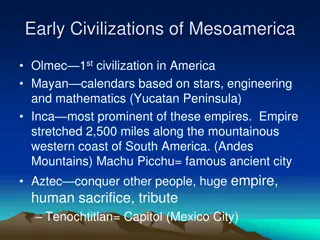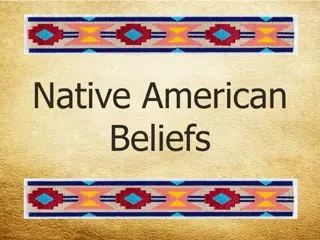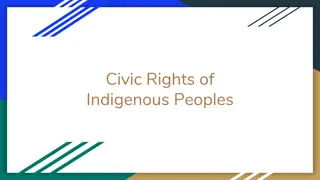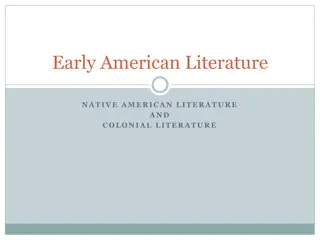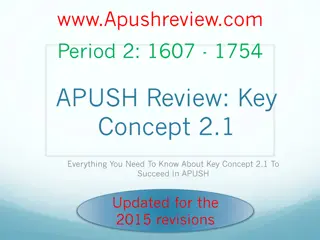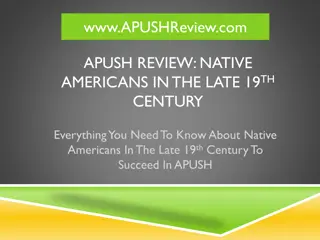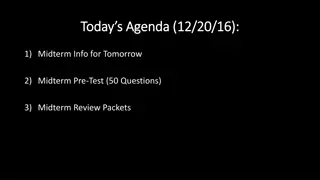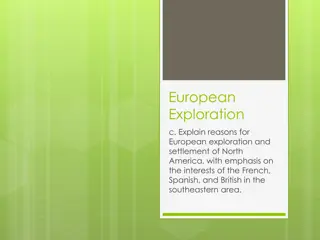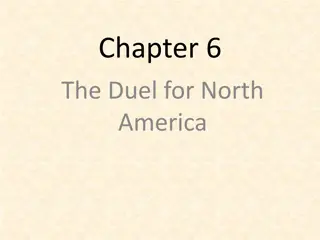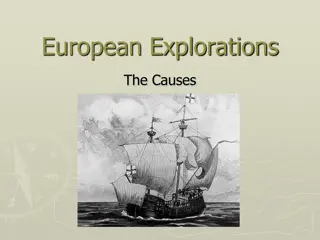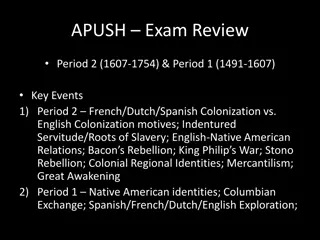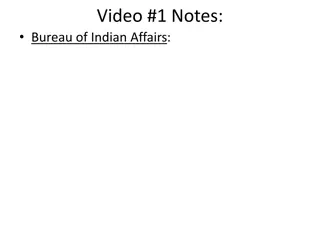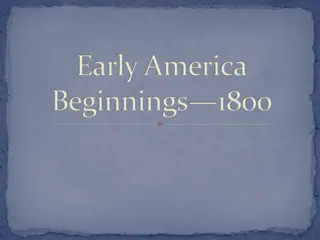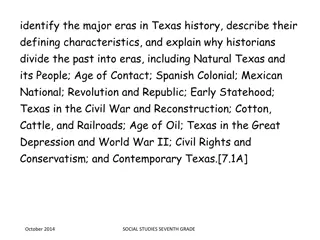Native American Cultures and European Colonization in APUSH Midterm Review
Explore key differences among Native American tribes pre-Columbus, noting similarities in matrilineal societies and religious practices. Delve into the impacts of European arrival on environment, culture, identity, and politics of Native Americans from 1492-1607, contrasting English, Spanish, and French colonization methods.
Download Presentation

Please find below an Image/Link to download the presentation.
The content on the website is provided AS IS for your information and personal use only. It may not be sold, licensed, or shared on other websites without obtaining consent from the author.If you encounter any issues during the download, it is possible that the publisher has removed the file from their server.
You are allowed to download the files provided on this website for personal or commercial use, subject to the condition that they are used lawfully. All files are the property of their respective owners.
The content on the website is provided AS IS for your information and personal use only. It may not be sold, licensed, or shared on other websites without obtaining consent from the author.
E N D
Presentation Transcript
APUSH APUSH - - Midterm Review Midterm Review
Period 1 (1491 Period 1 (1491- -1607) 1607) Question 1: What key differences exist among the Native Americans prior to the arrival of Columbus? What similarities did many tribes possess?
Possible Answers Possible Answers Differences (mainly regional) 1) SW: planned towns, agricultural-based, trade 2) West Coast: agriculture, fishing hunting 3) Plains: hunting 4) East of Miss River: hunting, agriculture; confederacies; trade-relations Similarities 1) Matrilineal societies 2) Devotion to land but no claim of ownership 3) High emphasis on religious ceremony/nature
Period 1 (1491 Period 1 (1491- -1607) 1607) Question 2: In what ways did the arrival of the Europeans directly change or alter the environment, culture, identity, and political structure of Native American Indians between the years 1492-1607?
Possible Answers: Possible Answers: Environment: new plants introduced, emphasis on fur-trade, introduction of the horse/livestock; new diseases Culture: firearms introduced; metal tools introduced; more emphasis on warrior-based culture Identity: introduction/effects of Christianity; end of matrilineal- dominance; effects of plagues on religious-social structure Political Structure: firearm possession = more political dominance over other tribes (Powhatan, Massasoit); military-trade alliances develop
Period 2 (1607 Period 2 (1607- -1754): 1754): Question 1: How did English colonization differ from that of the Spanish and the French?
Possible Answers: Possible Answers: Spanish French Mass enslavement of Indians Mass conversion of Indians to Catholicism Indians were both a labor force as well as subjects to Spain Colonies are spread between Catholic missions and small towns (with exception of Mexico City) Dependence on fur trade with Indians for profitability No conquest/taking of land No forced conversion Blending French-Indian cultures together Same spread out colonies as Spain (except for Quebec and New Orleans)
The English The English Motives: natural resources (originally gold but then land); religious freedom; check the power of Spain, France, Netherlands A more permanent settlement system, especially in NE (families, planned towns, social institutions) Exclusionary policy toward Indians (move them out by any means necessary, few conversion attempts)
Period 2 (1607 Period 2 (1607- -1754) 1754) Question 2: In what ways were the colonies of New England and the Chesapeake/Lower South different from one another in terms of environment, identity, labor, and culture?
Possible Answers: Possible Answers: New England -Environmental: temperate climate = less insect-borne disease; not conducive for cash-crop farming -Identity: Puritan/religious-based; strong sense of congregation and community -Labor: more individualized, less reliant on chattel slavery; agriculture, shipbuilding, fishing = three main industries -Culture: hard work and prayer
Possible Answers (contd) Possible Answers (cont d) Chesapeake/Lower South -Environment: sub-tropical climate; good for cash-crop farming; high rate of infectious disease = shorter life-span of residents -Identity: More Anglican than NE; less emphasis on religion, more on profit and individual success -Labor: Indentured servitude to chattel slavery (particularly in rice colonies of lower South) -Culture: large-scale, self-sufficient plantations = less community-based; closely resembles gentry lifestyle of England
Period 2 (1607 Period 2 (1607- -1754) 1754) Question 3: What key features made William Penn s proprietary colony of Pennsylvania different from many of her sister colonies of the time?
Possible Answers: Possible Answers: Toleration of all religious faiths Fair land-deals with Indians No organized militia Right to vote for all property-owning men Open to all different ethnic groups (Germans, Swedes, Dutch, etc.)
Period 2 (1607 Period 2 (1607- -1754): 1754): Question 4: In what ways could British political and economic influence be seen during this time period in the 13 colonies prior to the war for independence?
Possible Answers: Possible Answers: Political: -strong sense of English rights among colonists -all colonies were either proprietorships or royal colonies prior to 1776 -voting rights for propertied class Economic -impact of British slave trade (especially on South) -expectation that Britain would receive majority of colonial raw materials (mercantilism) -practice of salutary neglect with colonies (to keep us happy)
Period 3 (1754 Period 3 (1754- -1800) 1800) Question 1: In what ways did the French & Indian War change the political and economic relationship between Britain and the American colonies? How did the war contribute to the overall identity of America?
Possible Answers: Possible Answers: Colonists and Indians CANNOT co-exist; Royal Proclamation line (1763) is set in place To fund the continued defense of colonies, new taxes are imposed (sugar, stamps, etc.) = end of salutary neglect Both the British AND Colonists are opposed to the idea of a centralized colonial gov t (Albany Plan of Union) Mounting tensions from perceived colonial obedience to British rule leads to outbreaks of violence (Boston Massacre) and open defiance (Boston Tea Party) Identity: Some colonists see themselves more of a separate people capable of running their own affairs; others are quite content staying British
Period 3 (1754 Period 3 (1754- -1800) 1800) Question 2: What main ideas are included in ALL PARTS of the Declaration of Independence (not just the Preamble!)?
Possible Answers: Possible Answers: Preamble: When it becomes necessary to free oneself from a bad relationship, the proper thing to do is explain why our core rights as men are life, liberty, and happiness governments are established to protect these rights, and when they fail to do so we are entitled to change or get rid of said government...this is what King George III is doing to us Grievance List: HE HAS taken away our courts, restricted our rights to travel, subjected us to unfair taxes, etc. etc. Declaration: We have tried over and over to reconcile with the King but he has refused to listen to us. We therefore have no other choice but to declare ourselves free and independent states capable of doing any/all things sovereign states can do.
Period 3 (1754 Period 3 (1754- -1800) 1800) Question 3: What key factors enabled the American states to defeat Britain in the war for independence?
Possible Answers: Possible Answers: French alliance Distance of Britain from colonies Geographical size of colonies Length and expense of war/toll on British citizenry and economy Key victories (Trenton, Saratoga, Yorktown)
Period 3 (1754 Period 3 (1754- -1800) 1800) Question 4: In the aftermath of the war, what specific challenges was the United States facing?
Possible Answers: Possible Answers: Weak centralized government No standing army (only state militias) No navy Enormous state and national debt No uniform currency No trade regulation on states Lack of cooperation between states Sporadic outbreaks of rebellion against state gov t (Daniel Shays) Continued British-Native American threats in West
Period 3 (1754 Period 3 (1754- -1800) 1800) Question 5: How was a central government created by the Constitution? How was the Bill of Rights designed to check the power of the government?
Possible Answers: Possible Answers: 3 branches (legislative - Congress, executive - President, judicial Supreme Court/Federal Courts) Each branch has ability to check power of other Laws passed by fed. gov t are supreme to those of states Supreme Court members serve for LIFE (permanent body); Exec/Legis members are elected to terms of service Bill of Rights guarantees specific freedoms for individual from arbitrary government power: -freedom of speech, freedom of religion, right to trial by jury, no cruel/unusual punishment
Period 3 (1754 Period 3 (1754- -1800) 1800) Question 6: In what ways were Alexander Hamilton and Thomas Jefferson influential players in Washington s Administration?
Possible Answers: Possible Answers: Hamilton = secretary of treasury; advocates fed assumption of state debts, creation of national bank, building of an industrial base; believes in powerful central government led by best men ; supporter of Britain; originator/de facto leader of the Federalist party Jefferson = secretary of state; against bank and many of Hamilton s financial policies; supporter of an agrarian/expansive America with little federal interference; supporter of France/French Revolution; originator/de facto leader of the Democratic-Republican Party (Jeffersonians)
Period 3 (1754 Period 3 (1754- -1800) 1800) Question 7: What key warnings did Washington make to the nation in his Farewell Address of 1796?
Possible Answers: Possible Answers: Political Parties ( factions ) are dangerous, self-serving and will only tear our nation apart International alliances do more harm than good. Europe s affairs are their own; our affairs are our own.
Period 3 (1754 Period 3 (1754- -1800) 1800) Question 8: What foreign and domestic issues did John Adams face as President due to the continuing war between Britain and France?
Possible Answers: Possible Answers: Foreign: France is capturing/holding our merchant ships heading for Britain; Britain is impressing US citizens into service in the British navy; France continues on enacting the US-Franco alliance; bribery attempts during negotiations with France lead to XYZ affair and Quasi-naval war (but not declared war); Treaty of Mortefontaine ends US-Franco alliance Domestic: constant pressure from Jeffersonians to go to war against Britain with France; pressure from Federalists to respect the Jay Treaty and remain friendly with Britain; fallout of XYZ affair and anti-French, anti- Jeffersonian sentiment leads to passage of Alien & Sedition acts (President has power to imprison, deport, silence enemies/critics of gov t)
Period 4 (1800 Period 4 (1800- -1847): 1847): Question 1: In what ways was Jefferson s Administration a stark departure from that of Washington s and Adams s?
Possible Answers: Possible Answers: Reduces military spending Reduces size of military Greatly expands America s territory (Louisiana Purchase) Reduces Federalist debts Begins assimilation process with Native American tribes East of Mississippi
Period 4 (1800 Period 4 (1800- -1847) 1847) Question 2: In what ways did the War of 1812 contribute to the identity, the geography, and the ideas/beliefs of America in the years it was fought?
Possible Answers: Possible Answers: Identity: a sectional, divisive war (NE against, S/W in favor); adds confidence to America s psyche with a win ; dooms the fate of most Native American tribes east of the Mississippi Geography: secures territorial claims won from the Revolution; opens old SW to greater expansion/slavery Ideas/Beliefs: Should America fight an offensive war of conquest? Is it time to finish the remaining issues from the Revolution? Have we finally proven ourselves to the British?
Period 4 (1800 Period 4 (1800- -1847): 1847): In what ways was the practice of slavery different in 1800s America compared to how it was in the 1700s (in terms of labor, politics, culture, geography, and identity)?
Possible Answers: Possible Answers: Labor: cotton gin makes slavery MUCH more profitable than it was with tobacco planting; higher demand for slaves among cotton planters; 80-85% of slaves are field-hands Politics: several political compromises are fashioned determining where slavery can/cannot exist (Mizz Comp., 1850s Comp.); slave codes in South after Nat Turner become MUCH harsher Culture: Slavery is a way of life in South (their peculiar institution ); Moral issues concerning slavery begin in North during 2ndGreat Awakening Geography: Spreads through lateral migration but expansion brings new questions; economic concerns among Northerners about the difficulties competing with slavery Identity: THE most divisive issue of America s identity to date; completely sectionalizes America
Period 4 (1800 Period 4 (1800- -1847) 1847) Question 4: How did the overall expansion of the nation up to and beyond the Mississippi River contribute to the overall sectional tensions during this time period? What conflicts/resolutions came about during this time?
Possible Answers: Possible Answers: Source of tension: spread of slavery Louisiana Purchase: where can slavery go without an Ohio River present? Solution Missouri Compromise Texas: how do we admit Texas as a state WITHOUT upsetting the sectional balance of the Senate and causing conflict with Mexico? Solution Mexican/American War
Period 4 (1800 Period 4 (1800- -1847) 1847) Question 5: What was meant by the concept of Jacksonian Democracy during this time period? How was Jackson s Administration so different compared to his predecessors?
Possible Answers: Possible Answers: Jax Dem: An overall expansion of voting/electoral rights for white men (not just elite, property-owners). Rise of the common man in US politics. Major beneficiary: Democratic Party (refashioned by Jackson and Van Buren across state/sectional lines) Jax Admin: increases power of exec branch over other two branches in fed gov t; uses exec power for benefit of states rights (except during Nullification Crisis); uses the veto to check power of fed gov t (national bank, American System projects); clears way for white settlement East of Mississippi through Indian Removal Act
Period 4 (1800 Period 4 (1800- -1847): 1847): Question 6: What effects did the 2ndGreat Awakening have on the culture, identity, politics, and labor in the United States during this time period? What reforms came out of this movement?
Possible Answers: Possible Answers: Effects -Culture: evangelical Christianity takes off; individual must confront sins, repent, spread the word -Identity: a reaction to the market revolution and wealth being accumulated (as well as immigration of non-English Catholics); are we a nation of morals ? -Politics: early urban reforms begin; rise of nativist party factions ( know- nothings , etc.) -Labor: Is slavery a moral evil? Does the North practice wage slavery ? Reforms: public education, temperance, prisons, mentally ill, prostitution, abolition, women s rights
Period 4 (1800 Period 4 (1800- -1847) 1847) Question 7: What new patterns of immigration were seen in the United States during this time period? In what ways did native-born Americans respond to the influx of new people into the nation?
Possible Answers: Possible Answers: New Patterns: Irish-Catholics (cities)/German-Catholics (cities/mid- west); beginning of ethnic neighborhoods in cities Native Responses: Democratic Party city machines look to harness voting power of new immigrants (i.e. Tammany Society) through favors, political appointments, charity; rise of anti-Catholic, anti- immigrant factions (American Know-Nothing Party) try to curb immigration/naturalization of Catholic immigrants
Period 4 (1800 Period 4 (1800- -1847): 1847): Question 8: What successes and setbacks did the Abolition movement have during this time period? What characteristics made William Lloyd Garrison more of a radical than his contemporaries and peers?
Possible Answers: Possible Answers: Setbacks: no reaction from slave-owners through moral persuasion ; banning of abolition meetings in North and South; gag order in Congress due to influx of abolition material; censorship of abolitionist propaganda in South Successes: influence/popularity of Frederick Douglass helps spread and normalize the message in North; personal liberty laws begin to develop in Northern states during 1840s (due to Douglass s influence) Garrison Factor: attacks slavery as a moral evil ; calls for abolition AND immediate citizenship/enfranchisement of former slaves; also calls for women s rights/enfranchisement
Period 5 (1848 Period 5 (1848- -1877) 1877) Question 1: What factors made the Mexican-American war a sectional conflict in the years that it was fought (ending in 1848)?
Possible Answers: Possible Answers: Again, a sectional war (North against/South favors) for conquest of new territory (and the expansion of slavery) similar to War of 1812 Tactics used by Polk and propagated by Democratic newspapers to force a war with Mexico Far more costly/expensive/horiffic than previously anticipated; Mexican insurgency, disease, possible war crimes on both sides David Wilmot s proposed proviso (outlawing slavery in the lands gained from Mexico in Treaty of Guadalupe-Hidalgo)
Period 5 (1848 Period 5 (1848- -1877): 1877): Question 2: How did the events of the 1850s escalate the already existing sectional tensions in the nation prior to the outbreak of civil war?
